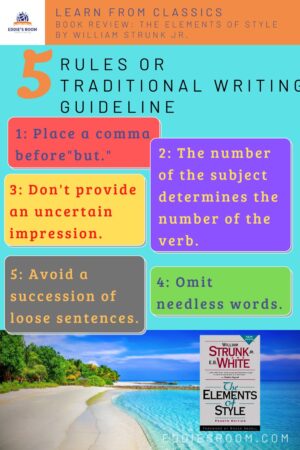The Element of Style is a English writing style book written by William Strunk Jr. in 1918, and published in 1920. It was actually 100 years ago.
The book has 100 pages, the content is dense so I think this is the best book to learn about traditional writing style.
There are 22 rules described in this book and I would like to pick up 5 rules here.
Rule1: Place a comma before a conjunction introducing an independent clause.
Honestly speaking, I haven’t pay attention to a comma. Now I can learn when I use a commna and when I don’t use it.
A comma can be used when the conjunction is “but“.
I have heard the arguments, but am still uncovinced.
And we should not use a comma before “and“.
He has had several years’ and is throughly competent.
Rule2: The number of the subject determines the number of the verb.
This is the area I may make a mistake. Now it’s clear to me. “None” is picked up as an example.
Use the singular verb when the meaning of “none” is “no one” or “not one.”
None of us are perfect.
None of use is perfect.
One of my favarite things is to understand the comparison between the 2 senteces; left side is the sentence without the rule and right side is the sentence with rule.
Use a plural verb when “none” suggests “more than one thing or person.”
None are so fallible as those who are sure they’re right.
Use singular verb even if other nouns are conected to it by with, as well as, in addition to, except, together with, and no less than.
His speech as well as his manner is objectionable.
Rule3: Put statements in positive form
If our sentence has a doubt, our writing will lack authority. So we have to be carefull when we use would, should, could, may, might, and can because we “may” provide uncertain impression.
If you would let us know the time of your arrival, we would be happy to arrange your transportation from the airport.
If you will let us know the time of your arrival, we shall be happy to arrange your transportation from the airport.
Applicants can make a good imporession by being neat and punctual.
Applicants will make a good impression if they are neat and punctual.
Rule4: Omit needless words.
We should try to simplify a sentence as much as possible by removing unnecessary words.
He is a man who
He
This is a subject that
This subject
Her story is a strange one.
Her story is strange.
I was unaware of the fact that
I wan unaware that
His cousin, who is a member of the same firm
His cousin, a member of the same firm
Rule5: Avoid a succession of loose sentences.
An unskilled writer will sometimes construct a whole paragraph of sentencdes of this kind, using as connectives and, but, and, less frequently, who, which, when, where and while, these last in nonrestrictive senses.
This means if we use “and” and “but” to connect sentences, it sounds boring with monotony.
We have to show the relationship between sentences and create logical sentences.


